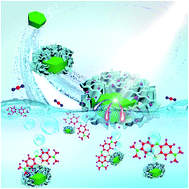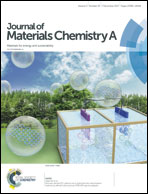Full-spectrum-activated Z-scheme photocatalysts based on NaYF4:Yb3+/Er3+, TiO2 and Ag6Si2O7†
Abstract
The development of efficient full-spectrum-activated photocatalysts has become a research topic of intense interest in environmental remediation or solar energy conversion applications. Herein, newly Z-scheme UV-vis-NIR-activated photocatalysts consisting of β-NaYF4:18% Yb3+, 2% Er3+@TiO2–Ag6Si2O7 (denoted as NaYF4@T–ASO) were designed and used as full-spectrum response photocatalysts. For tailoring NaYF4@T–ASO, the size of in situ deposited ASO nanoparticles on the surface of NaYF4@T microplates was determined by the pumping rate of the AgNO3 precursor, which played indirect roles in the photocatalytic activity with different carrier migration distances. Especially, NaYF4@T–ASO (S10) with the smallest and well distributed ASO nanoparticles showed superior photocatalytic activity than the commercial P25 TiO2 by 15 fold under the stimulated solar light irradiation. The enhanced photocatalytic performance of NaYF4@T–ASO could be ascribed to the synergic effect of the upconversion material and the direct Z-scheme heterojunction formed between TiO2/ASO, where the Z-scheme heterojunction induced efficient separation of photogenerated carriers and highly oxidative species (h+ and ˙O2−). Alternative mechanisms of carriers and energy transfer under various light sources have been proposed and discussed in detail.

- This article is part of the themed collection: 2017 Journal of Materials Chemistry A HOT Papers


 Please wait while we load your content...
Please wait while we load your content...